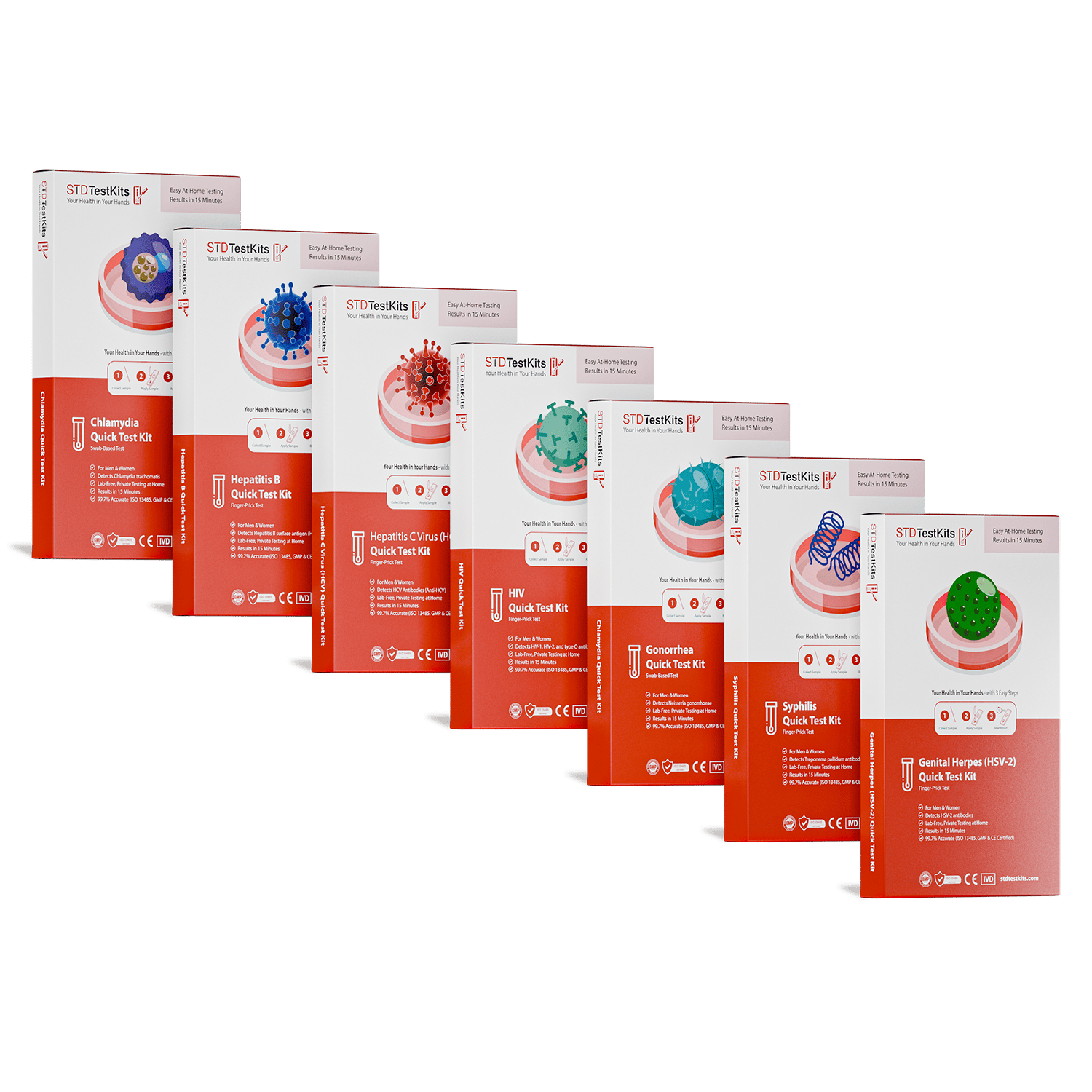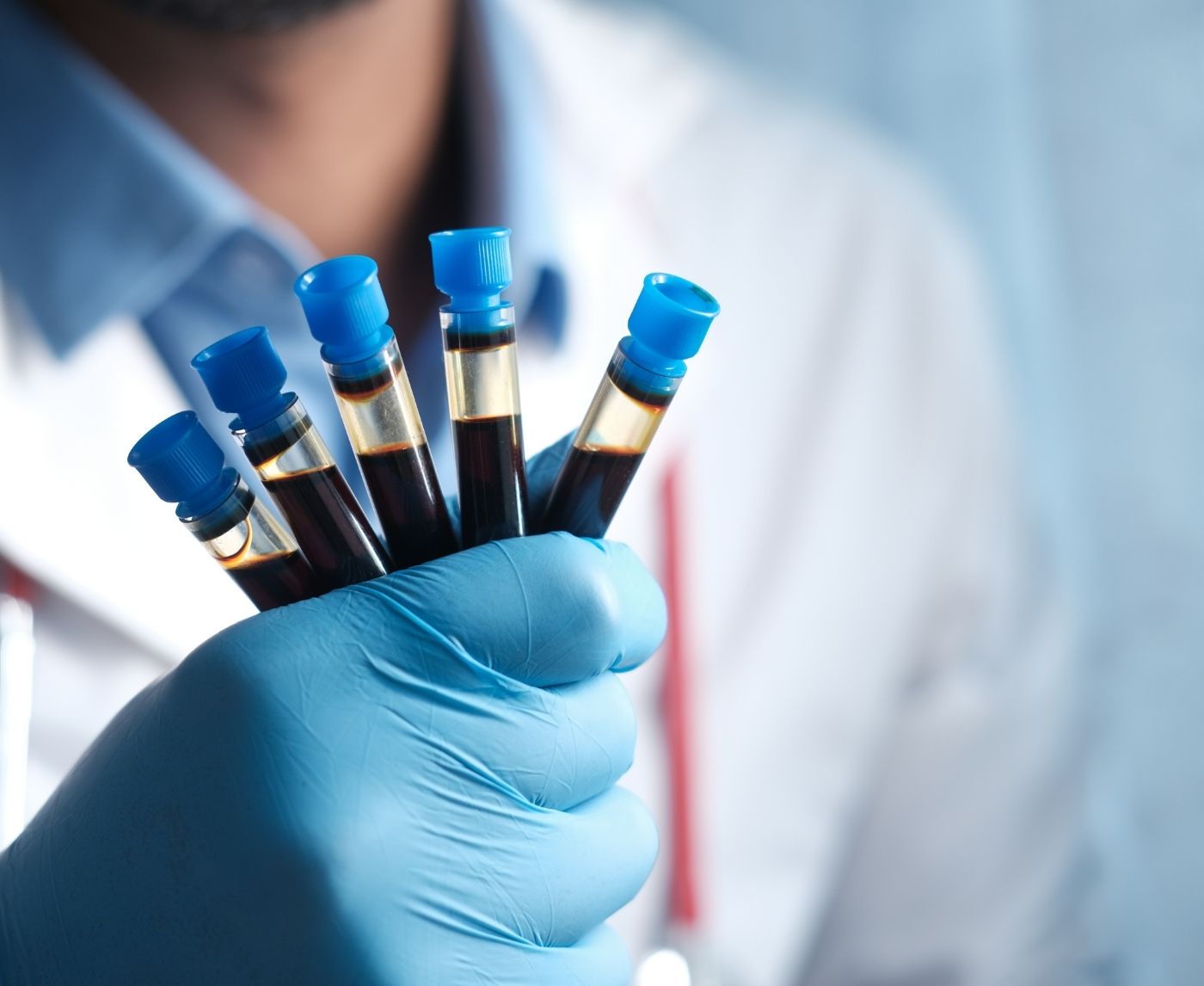How Soon After Sex Can You Test for HSV-1 or HSV-2?
Quick Answer: Yes, you can get an STD from oral or anal sex. Many STDs, including gonorrhea, herpes, syphilis, chlamydia, and HIV, can be transmitted without vaginal penetration.
“But We Didn’t Even Have Sex…”
“We didn’t even have sex” is a phrase doctors and sexual health nurses hear constantly. In medical terms, sex includes any act that transmits infection: oral, anal, genital, or even skin-to-skin rubbing. The idea that oral or anal play is a safer “gray zone” comes from a mix of outdated sex-ed, shame-based language, and urban myths about what “real sex” means. But from a clinical perspective, your body doesn’t care whether you label it foreplay or abstinence. Exposure is exposure.
Consider this: according to the CDC, nearly 37% of reported gonorrhea cases show up in the throat or rectum. Many go undetected because people don’t realize they were even at risk. You don’t need ejaculation, visible sores, or any kind of penetration to pass or receive an infection. Just contact. Saliva isn’t a barrier; it’s a vehicle.
This confusion has real consequences. Delayed testing means silent spread, and for STDs like syphilis or herpes, symptoms might never appear, or they’ll show up somewhere you’re not even looking, like the tonsils or inner cheeks.
Oral Sex and STDs: What the Data Really Shows
Let’s break it down. Not all STDs spread equally through oral sex, but many do, and some even prefer it. Here’s what we know from peer-reviewed studies and clinical surveillance:
| STD | Can It Spread via Oral Sex? | Common Oral Symptoms |
|---|---|---|
| Chlamydia | Yes | Often none; possible sore throat or mild redness |
| Gonorrhea | Yes | Sore throat, swollen glands, no symptoms at all |
| Herpes (HSV-1 & HSV-2) | Yes | Cold sores, ulcers in the mouth or on lips |
| Syphilis | Yes | Painless sore (chancre) in mouth, tongue, lips |
| HPV | Yes | Warts inside mouth or throat (rarely visible) |
| HIV | Yes (rare, but possible) | None initially; systemic later |
Table 1: Common STDs transmissible through oral sex and their typical symptoms, though most are often asymptomatic in the mouth or throat.
Part of the problem is where symptoms show up, or don’t. You could carry gonorrhea in your throat and never feel it. That makes it easier to unknowingly pass it to someone else during oral sex. Even testing isn’t always intuitive: unless you specifically ask for a throat or rectal swab, your standard urine test might miss it completely.
If your partner had a sore or rash that brushed against your lip, you could now be carrying HSV-2 orally, yes, even if they never ejaculated, and even if they “felt fine.” Herpes spreads most during outbreaks, but it can still shed silently in the days before. This is why condom use during oral doesn’t eliminate risk, it just reduces some kinds of it.

People are also reading: Why Nevada’s STD Surge Isn’t Just a Vegas Problem (But It Should Scare Us All)
Anal Sex: The Highest Risk, Still the Least Talked About
Let’s talk about anal. Among all sex acts, unprotected anal sex carries the highest risk for HIV transmission. That’s because the lining of the rectum is extremely delicate. Tiny tears, sometimes microscopic, can allow viruses and bacteria direct access to the bloodstream. This is true for both receptive and insertive partners, regardless of gender or orientation.
For Keisha, 32, it wasn’t just one mistake, it was trust. Her long-term partner said he was “clean,” and they only had anal sex. She thought that meant the risk was lower. Three months later, she tested positive for syphilis, a painless sore had appeared near her anus, which she initially mistook for an ingrown hair. What scared her wasn’t just the infection, it was how easily she could have missed it if it weren’t for routine testing after a friend’s scare.
Many rectal STDs are asymptomatic, especially in the early stages. But that doesn’t mean harmless. Gonorrhea in the rectum can trigger discharge, itching, or pain, but in many cases, there’s no sign at all. HPV can linger silently and cause anal warts or even elevate cancer risk long-term. Yet these infections are rarely discussed unless you’re already part of a high-risk group or actively seeing a specialist.
Why You Might Not Know You’re Infected (Yet)
Here’s the tricky part: most oral or anal STDs don’t show up in ways people expect. You might not see any discharge, bumps, or pain. That’s because these areas, throat and rectum, don’t always respond with obvious symptoms. You could feel completely fine and still be contagious.
Even common screening misses these infections unless you ask for specific site testing. A urine test won’t detect rectal chlamydia. A throat swab is needed to find oral gonorrhea. And many clinicians don’t offer multi-site testing unless you disclose your exposure, which most people don’t, either from embarrassment or because they genuinely didn’t know it mattered.
Let’s look at the types of tests and where they work best:
| Sample Type | Best for Detecting | May Miss |
|---|---|---|
| Urine Sample | Genital chlamydia, gonorrhea | Oral and rectal infections |
| Throat Swab | Oral gonorrhea, chlamydia, HSV | Genital or rectal STDs |
| Rectal Swab | Anal chlamydia, gonorrhea, syphilis, HSV | Oral or urinary STDs |
| Blood Test | HIV, syphilis, hepatitis | Local bacterial infections |
Table 2: Testing site and sample types , why multi-site screening matters for oral and anal exposures.
So if you’re relying on a negative urine test to mean you’re “clean,” you might be missing critical infections. This doesn’t make you careless, it makes you normal. Most people don’t know how STDs behave beyond genital symptoms, and even fewer are given the tools to ask the right questions. That’s why proactive testing and awareness are the only real protection.
What Protection Actually Works (and What Doesn’t)
Let’s clear up one of the biggest myths: condoms only protect what they cover. That means during oral sex, if the penis, vulva, or anus isn’t fully covered, exposure risk remains. Even then, condoms don't guard against everything, herpes and HPV can spread from skin-to-skin contact outside the barrier area. And while dental dams offer some safety, they’re rarely used in casual hookups or even committed relationships.
“I thought using a condom during oral was weird,” says Mateo, 29. “It felt awkward, so we skipped it. I didn’t even know you could catch chlamydia in your throat.” That’s a common belief, but it comes with consequences. Studies show oral gonorrhea can be passed even with a condom if there’s oral contact with the testicles, base of the penis, or surrounding skin. Condoms reduce risk, but nothing short of abstinence eliminates it.
Some people think mouthwash or brushing teeth before oral sex helps. Unfortunately, vigorous brushing can create microtears in the gums, actually increasing susceptibility to infections. Mouthwash may kill surface bacteria, but it doesn’t touch viruses or deeper-seated pathogens like gonorrhea or HSV.
If you want to lower your risk during oral or anal sex, here’s what actually helps: use condoms or dental dams, avoid contact when symptoms are present (even mild ones), get vaccinated for HPV and Hepatitis B, and test regularly based on your exposure, not just symptoms.

People are also reading: Why Nevada’s STD Surge Isn’t Just a Vegas Problem (But It Should Scare Us All)
Testing After Oral or Anal Sex: When Timing Matters
Testing too early can give you a false sense of relief. Every STD has a “window period”, the time between exposure and when it shows up on a test. That means if you hooked up last weekend, rushing to test the next day might not give you real answers.
Here’s a simplified scenario: Sam gave oral sex at a party. Five days later, they were anxious and went to a clinic. Their test came back negative, but the provider warned that gonorrhea might not show until day seven or later. Two weeks later, Sam developed a sore throat and returned. A throat swab this time tested positive.
The key takeaway? Earlier isn’t always better. Here's a general guide for oral/anal exposure:
| STD | Earliest Detection | Best Time to Test |
|---|---|---|
| Gonorrhea | 5–7 days | 7–14 days |
| Chlamydia | 7 days | 14 days |
| Syphilis | 3 weeks | 6 weeks |
| Herpes (blood test) | 3–6 weeks | 12 weeks |
| HIV | 10–14 days (NAAT), 2–4 weeks (Ag/Ab test) | 4–6 weeks |
Table 3: Window periods after oral or anal exposure. Testing too soon may miss early infections, retest windows are essential.
Remember, symptoms, or the lack of them, don’t tell the whole story. You can carry an oral infection without pain or discharge. That’s why retesting matters too, especially if your first test was soon after exposure or if new partners are involved.
If your head keeps spinning, peace of mind is one test away. This discreet at-home combo test checks for multiple infections from a single sample, and no awkward clinic wait required.
Case Study: “It Was Just Oral. I Didn’t Think I Could Get Anything.”
Ty, 26, had never tested positive before. He prided himself on being careful. “We didn’t even have sex. I just went down on him for like… a minute. No one came.” Two weeks later, Ty started feeling feverish, with swollen tonsils and a slight rash on his arms. His doctor thought it might be strep, until the swab came back negative and his bloodwork flagged something else. A syphilis test confirmed it.
Ty was shocked. He hadn’t noticed any sore, no discharge, nothing that screamed “STD.” That’s the stealth of syphilis. The first sore, called a chancre, can appear in the throat, rectum, or genitals and often goes unnoticed. It heals on its own, but the bacteria spreads silently in the bloodstream. Weeks later, it can cause flu-like symptoms and rash. Left untreated, it can cause neurological issues or permanent damage.
“No one told me oral sex could lead to this,” he said. “I thought I was being safe.” Ty’s story isn’t rare. And it’s why we need to rethink what “safe sex” really means.
When the Risk Isn’t Just Physical
The hardest part about STDs from oral or anal sex isn’t always the diagnosis, it’s the shock. Many people don’t get tested because they don’t believe they were even “at risk.” That confusion delays treatment, spreads infection, and fuels shame that shouldn’t exist in the first place.
STDs aren’t a punishment or a mark of irresponsibility. They’re a biological possibility in any intimate exchange. Whether you’re queer, straight, poly, celibate for months or sexually active every week, none of that changes the science of transmission.
So if you’ve ever said “But we didn’t even have sex,” you’re not alone. You’re part of a generation that was under-informed, shamed out of asking questions, or taught to treat pleasure like a secret instead of a shared human experience.
Testing isn’t a confession. It’s care. It’s a moment of clarity in a world that rarely gives us clean lines. Whether it’s a sore you’re ignoring or a hookup you didn’t plan, the answer isn’t silence. It’s science, and a good test.
Return to STD Rapid Test Kits to explore testing options made for real life, fast, private, and ready when you are.
FAQs
1. Can you really get chlamydia from oral sex?
Yep, and it happens more often than you’d think. Giving oral to someone with chlamydia can leave you with a throat infection, even if they didn’t finish or show any symptoms. Most people with oral chlamydia don’t feel a thing, which is why it flies under the radar. You won’t always cough or feel sore. That’s the trap.
2. Is anal sex automatically more dangerous?
Not automatically, but it does carry a higher risk for certain infections like HIV and syphilis. That’s because the lining of the rectum is thinner and more prone to tiny tears, even when you're being gentle. Those micro-tears are like open doors for bacteria and viruses. It doesn’t mean anal is “bad”, it just means protection and timing matter more than people realize.
3. If I don’t swallow, I’m safe, right?
Not quite. STDs don’t need a grand finale to do their thing. Even brief oral contact can transmit things like herpes, gonorrhea, or syphilis. The bacteria lives in the throat, mouth, and genitals, so whether or not you swallow doesn’t cancel out the risk. Sorry to be the buzzkill.
4. Can I have an STD in my throat or rectum without symptoms?
Totally. That’s actually super common. You could be walking around with oral gonorrhea or rectal chlamydia and not feel a single thing. No burning, no discharge, no sore. That’s why multi-site testing matters, urine tests won’t catch what’s happening in your throat or back door unless you specifically swab those areas.
5. Do dental dams actually work or are they just for textbooks?
They do work, but yeah, no one teaches how to use them in real life. If used correctly, they can lower your risk during oral-vulva or oral-anal play by creating a barrier. Think of it like a condom for the mouth. Most people never use them, but that’s not because they don’t work, it’s because nobody talks about them outside of sex-ed slides from 1999.
6. Can brushing your teeth before oral sex raise your STD risk?
Weirdly, yes. Brushing too hard or flossing right before can cause micro-cuts in your gums, tiny open doors for viruses and bacteria. If you’re about to get oral, it’s better to rinse than scrub. Think of it like prepping for a tattoo: clean, but don’t irritate the canvas.
7. Do condoms protect you during oral and anal sex?
They help a lot, but they’re not bulletproof. Condoms reduce exposure to fluids, which is key for infections like HIV or chlamydia. But they don’t cover everything, like herpes or HPV, which spread via skin contact. And with oral sex, most people skip them entirely, so the risk rises fast. Bottom line: they’re better than nothing, but not a guarantee.
8. Can I still get tested if I’m not sure what kind of sex “counts”?
100%. You don’t have to have a script ready. Just tell the provider, or select on your test form, that you’ve had oral or anal exposure. A good at-home test (like the combo kit) gives you multiple sample options. You don’t need the perfect words, just a test that meets your life.
9. Will my test say where the infection is, mouth, rectum, genitals?
Only if the sample came from that spot. That’s why site-specific testing matters. A urine test only shows what’s happening in your urethra. If you got exposed through oral or anal sex, make sure to use a throat or rectal swab. It’s like trying to find a leak in the roof by checking the basement, it won’t show unless you’re looking in the right place.
10. Do I really have to tell a partner if I got an STD from oral?
Morally? Yeah. Medically? Also yeah. Even if it wasn’t “real sex” by your definition, the infection still spread. The good news is, you can tell them without turning it into a shame spiral. You don’t owe them an essay, just honesty so they can test, treat, and not pass it along. That’s not drama, it’s damage control.
You Deserve Answers, Not Assumptions
Oral and anal sex don’t come with warning labels. No one stands over your shoulder mid-hookup to tell you what bacteria might be hiding in a throat, on a lip, or just under the skin. But the risks are real, and the silence around them keeps people guessing instead of getting tested.
You deserve better than myths and half-truths. You deserve clear information, tools that work, and testing options that meet you where you are. Whether you're wondering about a sore throat, a silent partner, or a memory that’s nagging you, don’t guess. Test. It’s fast, private, and easier than you think.
Don't wait and wonder; get the answers you need. This at-home combo test kit checks for the most common STDs quickly and without drawing attention to itself.
How We Sourced This Article: We combined current guidance from leading medical organizations with peer-reviewed research and lived-experience reporting to make this guide practical, compassionate, and accurate.
Sources
1. CDC – About STI Risk and Oral Sex
2. Syphilis Transmission: A Review of the Current Evidence
3. Oral Manifestations of Syphilis: Report of Four Cases
4. CDC – Transmission of Syphilis by Oral Sex (MMWR)
About the Author
Dr. F. David, MD is a board-certified infectious disease specialist focused on STI prevention, diagnosis, and treatment. He blends clinical precision with a no-nonsense, sex-positive approach and is committed to expanding access for readers in both urban and off-grid settings.
Reviewed by: S. Langston, MPH | Last medically reviewed: September 2025
This article is just for information and should not be used as medical advice.







